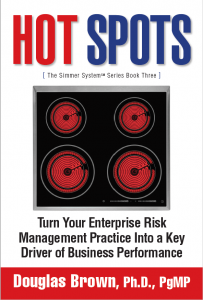Turn Your Enterprise Risk Management Practice Into a Key Driver of Business Performance (Simmer System Series Book 3)
Does your organization really buy into risk management, or is it just another compliance exercise?
Or does it stop when you turn in the risk assessment matrix (the colored “risk square”) or risk register that you had to slap together to get the project approved?
What is risk management anyway? All too often, it is seen as just another cost sink and overhead effort. But it doesn’t have to be that way. Risk management is at the very core of project management, and when done right it is a business process that provides real value to the overall business management effort.
Project, program and risk managers will enjoy this book’s pragmatic advice, taking away practical ideas for gaining the organizational acceptance needed to apply a risk management framework effectively, and will have access to an online supplementary resource site with exercises, templates and training. The book MAY NOT be for you if you are interested in financial investment portfolio risks as opposed to business or project management.
Here’s a little quiz to see if we’re thinking on the same wavelength:
In which phase of the project life cycle do the risk management activities occur?
A. Planning
B. Execution
C. Control
D. Close-out?
Of course “none of the above” would have been wrong! Did you insist that the correct answer should be “all of the above”? Then you’re on the right track. Risk management is inherent in every phase of the project life cycle, providing a steady view of the likely outcomes and a means of adjusting to emerging realities.
How often have you heard PMO staff and program managers complain that they just knew a project was going to fail, right from the beginning? What kind of business plan is that? How was it allowed to proceed? Doesn’t the orgnaization want to meet its Key Performance Indicators (KPI) needed to make the business strategy work?
Probably your organization is going to make you commit to a point estimate. Why? Because Microsoft Project and other project management software tools can’t handle ranges of estimates. Nor can the CFO’s budgeting tools. They aren’t going to allow you to keep a project reserve, and they probably won’t going to tolerate much funding for mitigation actions (forget about setting up that contingency fund). So why bother?
If you’re a project manager, you’ll want to know how to bake risk analysis, monitoring and control into your projects’ key activities and carry them out without those sharp-eyed accountants pulling the risk mitigation funds away. If you are a program manager or enterprise risk manager, you’ll want to make sure that you are doing what you can to create a risk-aware environment that makes it possible for project managers to carry out their projects with the support of realistic risk management plans that ensure genuine risk reduction.
The book will offer you practical new ideas for:
-
- Injecting risk management into project activities\
- Gaining the business acceptance they will need to move risk management off the shelf and into the mainstream
- Dealing with the often-overlooked and in fact much larger matter of operational risk management after the projects are over.
Ownership of the book also opens the door to an online set of templates and resources and a community of project managers and risk managers who are working through the same challenges.
About the Author: [details] Dr. Douglas Brown, PhD, PgMP, PMP, has formed and led PMOs and risk management practices in both commercial and government organizations over the past 25+ years, and is a regular speaker at various PM and IT industry venues. He pulls together that experience to really show you how you can transform your risk management practice from dusty shelfware to a key business performance management resource that drives project and program success.

